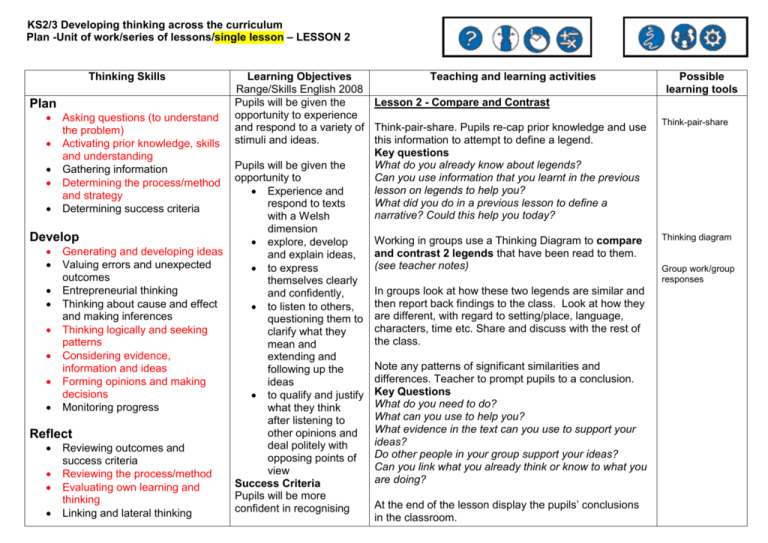KS2 - Developing thinking across the curriculum
advertisement

2KS2 KS2/3 Developing thinking across the curriculum Plan: Plan -Unit of work/series of lessons/single lesson – LESSON 2 Thinking Skills Plan Asking questions (to understand the problem) Activating prior knowledge, skills and understanding Gathering information Determining the process/method and strategy Determining success criteria Develop Generating and developing ideas Valuing errors and unexpected outcomes Entrepreneurial thinking Thinking about cause and effect and making inferences Thinking logically and seeking patterns Considering evidence, information and ideas Forming opinions and making decisions Monitoring progress Reflect Reviewing outcomes and success criteria Reviewing the process/method Evaluating own learning and thinking Linking and lateral thinking Learning Objectives Teaching and learning activities Range/Skills English 2008 Pupils will be given the Lesson 2 - Compare and Contrast opportunity to experience and respond to a variety of Think-pair-share. Pupils re-cap prior knowledge and use stimuli and ideas. this information to attempt to define a legend. Key questions What do you already know about legends? Pupils will be given the Can you use information that you learnt in the previous opportunity to lesson on legends to help you? Experience and What did you do in a previous lesson to define a respond to texts narrative? Could this help you today? with a Welsh dimension Working in groups use a Thinking Diagram to compare explore, develop and contrast 2 legends that have been read to them. and explain ideas, (see teacher notes) to express themselves clearly In groups look at how these two legends are similar and and confidently, then report back findings to the class. Look at how they to listen to others, questioning them to are different, with regard to setting/place, language, characters, time etc. Share and discuss with the rest of clarify what they the class. mean and extending and Note any patterns of significant similarities and following up the differences. Teacher to prompt pupils to a conclusion. ideas to qualify and justify Key Questions What do you need to do? what they think What can you use to help you? after listening to What evidence in the text can you use to support your other opinions and ideas? deal politely with Do other people in your group support your ideas? opposing points of Can you link what you already think or know to what you view are doing? Success Criteria Pupils will be more At the end of the lesson display the pupils’ conclusions confident in recognising in the classroom. Possible learning tools Think-pair-share Thinking diagram Group work/group responses the features of a legend. Talk partners Pupils will be able to recognise the strategies used to help them meet the learning objectives. Evaluation of Learning and Teaching Reflection Ask pupils to ‘think about their thinking’, to reflect on strategies used. Key Questions What was successful? What helped? What steps did you take to reach your conclusion? What did you find difficult? How could you improve next time? Could processes used in this lesson (that helped your thinking) be used in other lessons?



![afl_mat[1]](http://s2.studylib.net/store/data/005387843_1-8371eaaba182de7da429cb4369cd28fc-300x300.png)




